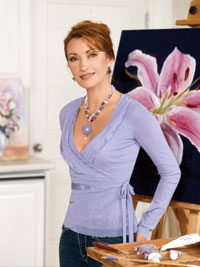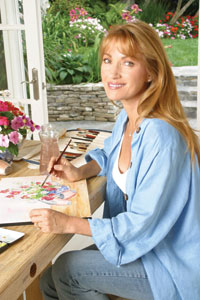 Photo by Charles Bush
Photo by Charles BushQ. You turned to art at a very challenging time in your life. Describe that experience and how art uplifted you.
A. Well, I painted and drew as a child, but I hadn’t really done very much with art until I turned 40 and found out that my life was changed forever. The relationship I had with my husband was not the one I thought I had; I went through a terrible divorce, and I lost all my money, my homes, everything. At a time when I could have had a nervous breakdown, I gave the money I had to an artist named Tom Mielko as a donation at a silent auction for a child-abuse agency I am involved with. He came to my house to do a drawing of my children and saw the finger paintings I had done of my kids hanging in the nursery. He offered to give me some lessons free of charge, and that is how I started. I went from being in a state of fear and shock and trauma to being totally pacified by the art that surrounded me—I just couldn’t stop creating. It really was my refuge. I turned to art for healing.
Q. Do you remember the first piece you created?
A.
Absolutely! It was a boat on a lake with very simple watercolor washes and some reeds on a huge piece of paper. I remember Tom explaining to me how I had to soak this paper in a bathtub and then stretch it out and the whole number. I was terribly worried that if I made one wrong move it would all be over, and I wouldn’t have another piece of paper to work on. But he put me through my paces, and I really took to it. I just love the light touch of watercolor. I love the translucence. I love the different textures I can get. Tom showed me everything from washes to brushstrokes to spattering with a toothbrush. I learned the different techniques, and then I kind of took off on my own and started doing my own thing with watercolor.

Q. Even though you are in a much better place, do you still think of art as your refuge?
A. Absolutely. Whenever I am dealing with something very stressful or very painful, I turn to art. For example, when my mom had a stroke last year and she was dying, I would spend hours and hours sitting there watching her. She was unable to move and unable to speak, and there was nothing I could do except just be there with her. I took my watercolors with me and talked to her about life and at the same time painted the flowers by her bed or the view from her window. I used painting and drawing as something that could calm me and put me in a good faith. People always say, “How do you find time to paint?” And I will say, “Well, people always find time to do things that they enjoy and love.” I don’t pressure myself with what the final piece will look like; I just try to enjoy the moment and the process.

Q. Now, your artwork can be found in countless galleries, and you’ve even branched out into jewelry and home-decor products. Why do you think your art resonates so well with viewers?
A.
Art critics, professors and others always say that my art is very authentic and that I’m not afraid of color. I think it’s more that I’m not afraid of trying different techniques and mediums. A lot of artists perfect one thing and do the same images and the same idea over and over. I think when people come to my shows, they see so many different styles and different subject matters, techniques and materials that I use. Sometimes they are kind of confused and ask why they see so many different things. If you look at my acting, you’ll see that is very different, too. I play a lot of different characters—it’s just who I am. I respond to different stimuli at different times for making art pieces. It’s very personal. Whoever said that my art is authentic is right; it’s a very personal statement—an emotional response to whatever subject matter I am working in.

Q. What styles and mediums are you experimenting with now?
A.
I’ve been doing a lot of semi-abstract “Open Heart” pieces. They came out of nowhere, and I just love it. I ended up doing continual lines in the “Open Heart” pieces, and they’ve been so successful that I literally sell out of them when I have a show. And, as you probably know, Kay Jewelers has picked it up and turned it into an amazing line of jewelry that they asked me to design. Now I’m actually writing a book about what it means to live with an open heart, so I’m quite excited.I’m also making a movie (“Dear Prudence,” Hallmark Channel, Aug. 23) right now, and I’ll be painting in one of the scenes. As we speak today I am in Alberta, Canada, looking at the most spectacular snowcapped mountains, a rushing river and trees with some Indian prayer ties whose colorful fabrics fly in the wind. I’ve been taking lots of photographs, and I’m probably going to be attempting that painting if I have time.

Q. Other than the movie you are working on, what other recent experiences have influenced your art?
A.
I did a whole series of women in red dresses with the idea of alerting women to the dangers of heart disease, but then I felt that red was like a celebratory color for women and that there is something very powerful about a woman in a red dress. So, I did a series of women from different ethnic backgrounds dancing. (This was before I did “Dancing with the Stars.”) There is something about the energy and movement of a dancer; I’m always looking for someone who can put a lot of energy into the pose, so that was fun.
Q. You’ve been an inspiration in so many ways to women all over the United States. What would you like to say to those women?
A.
I want to empower people to believe that when life gets tough, if you open your heart—literally—and live in the present moment and let go of the past, you can move on and discover creativity and joy in your life.
Q. What makes visual art different from acting, writing or any of the other career endeavors that you’ve taken on over the years?
A.
For me, what’s very special is that art is something I can see and that I create, and nobody else is involved in it. It’s something I do for myself. The excitement is when it speaks to someone, or someone wants to purchase it, or it moves a person to tears. I feel that I have communicated on a much more personal level through my art than when I am acting.

Q. How do you think success has changed your life?
A. I don’t really think about success. For me, I suppose success is about being happy, enjoying life and being creative. I don’t think of it in any other way. Finding happiness and having happy children—that’s what is important. The other stuff comes and goes. Just as in my art, I’m not really about the end result; I’m more about the process.
Q. So, what’s next for Jane Seymour?
A. I’ll finish this movie on June 20, and then I’ll go back to writing the book and putting the artwork for that together.
I am still, of course, designing home furnishings and designing more jewelry, and then I have a one-woman art show in
Carmel, Calif. I’m literally booked until the beginning of August, and I’ve got art shows booked until August of next year. What’s next for Jane? I don’t know. I’d have to look at my schedule! One minute I’m acting; the next minute I’m painting; the next minute I’m designing. But it doesn’t stop my mind from traveling in all directions at all times. It’s not compartmentalized; it’s all a part of my life.
ABN
Source
Coral Canyon Publishing: 310-456-9477; www.janeseymour.com
©ArtBusiness News -Jennifer Dulin Wiley, ABN Managing Editor